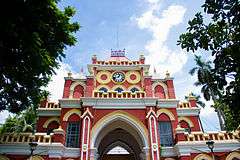Uttara Gonobhaban
Coordinates: 24°25′12″N 88°59′28″E / 24.42000°N 88.99111°E
| Uttara Gonobhaban | |
|---|---|
 Clocktower gate at the Uttara Gonobhaban | |
| General information | |
| Architectural style | Indo-Saracenic architecture |
| Town or city | Natore |
| Country | Bangladesh |
| Completed | 19th century |
The Uttara Gonobhaban (Bengali: উত্তরা গণভবন, lit. Northern People's House) is a 19th-century Bengali country house and retreat, it is located near the town of Natore in North Bengal.[1] It serves as the principal residence of the Bangladeshi Prime Minister in the northern part of the country. It was formerly the seat of the Dighapatia Raj-[2] an aristocratic landed estate in the Bengal Presidency of the British Raj. It has been used as a ceremonial site for receiving foreign ambassadors.
History

There has been a house on the site since the early 18th century, when the Nawab of Bengal rewarded Dayaram Roy for suppressing a rebellion. Roy was awarded the title of Jagirdar and given the zamindari of vast tracts of land in Jessore, Rajshahi, Bogra and Mymensingh. When the British Empire enforced the permanent settlement in Bengal, the Roys were recognized as landed Maharajas. They were avid followers of European influence, fashion, art and culture. Their palace was developed on the outskirts of Natore in the 19th century. The town of Natore served as the headquarters of Rajshahi Division in the Bengal Presidency, and thus was an important administrative centre. Following Partition in 1947, the estate was formally abolished during major land reforms in East Bengal.
On 24 July 1967, it was designated as a gubernatorial residence by Abdul Monem Khan, the Governor of East Pakistan. The palace was used by President Ayub Khan as a retreat when Bangladesh was a part of Pakistan as its eastern wing. After the independence of Bangladesh, Prime Minister Sheikh Mujibur Rahman, the founding father of the Bangladeshi republic, declared the palace as his official residence in northern Bangladesh on 9 February 1972.[3] It has since been used by successive Bangladeshi heads of government for holding cabinet, political and diplomatic meetings outside the capital.
Architecture
The palace area occupies around 43 acres (17 ha) of land or around 25 bighas, enclosed within a moat and a high perimeter wall. The estate also contains few lakes and greenery. The front gate entrance houses an imposing four-storied pyramidal gateway with a clock tower. It is also contains a series of arched openings on three storeys and two circlets flanking the clock on the top storey.
The 'E' shaped east facing facade is over a 100 ft long and has a prominently protruding porch in the center. In addition, two slightly projecting wings exist on both ends. The facade is decorated with floral designs in its plasterwork. A series of pointed trefoil arched openings provide access to the building across a running balcony in front. The parapet on the roof is decorated with merlons. The hemispherical dome with a sharp finial atop covers the central foyer.
The palace block houses nine sleeping chambers, a durbar hall, a dining hall and a danceroom. The ceiling of the durbar hall is over 25 feet from the floor and is much higher than the flanking apartments. The ceiling is decorated with painted floral motif in wood set in bays. Although the palace ground was plundered in various times in history, there are still some beautiful pieces of relics such as the neo-classical bronze Greek statues, flower vases, chandeliers, carved wooden bedstead and princely furniture. The main foyer also displays two armoured knights.
The southern wing of the palace is similarly designed in the shape of an 'E'. There is a large garden in the front with a fountain and a few life-size marble female sculptures located at the four corner porticoes. A broad verandah in front leads to a large foyer and beyond, to a series of apartments. The roof of the verandah is carried on semi-Corinthian columns alternated by trefoil arches. A rear verandah on the western end of the block overlooks a part of the moat. The bathroom is made entirely of marble.[4]
The 'Kumar Palace' (literally Prince's Palace) located to the southeast, close to the main palace compound is a two-storeyed building that houses four main bedrooms and a dressing room on the upper floor and a series of apartments on the ground floor. The small treasury hall stands directly behind the Kumar Palace. There also exists the single storeyed 'Rani Mahal' (Queen's Palace) to the south of the main palace block, originally occupied the vast fortified area of the palace. The guesthouse, stables, the servants' quarters etc. have all disappeared with time and at the aftermath of the earthquake of 1897.[5]
Gallery
See also
References
- ↑ Elliott, Scott (2015-10-08). Experiencing Bangladesh: Touring and Expatriate Life. Lulu Press, Inc. ISBN 9781329600935.
- ↑ "Ittyadi at Uttara Gonobhaban". The Daily Star. Retrieved 2016-04-02.
- ↑ Former Presidential Palace Neglected "Probe News" Anwarul Quadir
- ↑ Natore Uttara Gonobhaban " Beautiful Bangladesh"
- ↑ Ahmed, Nazimuddin (2012). "Dighapatia Rajbari". In Islam, Sirajul; Jamal, Ahmed A. Banglapedia: National Encyclopedia of Bangladesh (Second ed.). Asiatic Society of Bangladesh.






